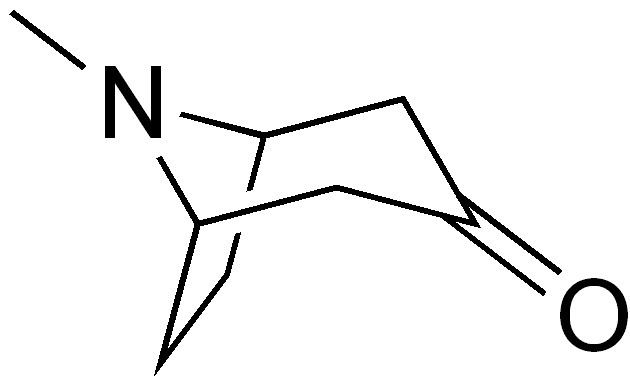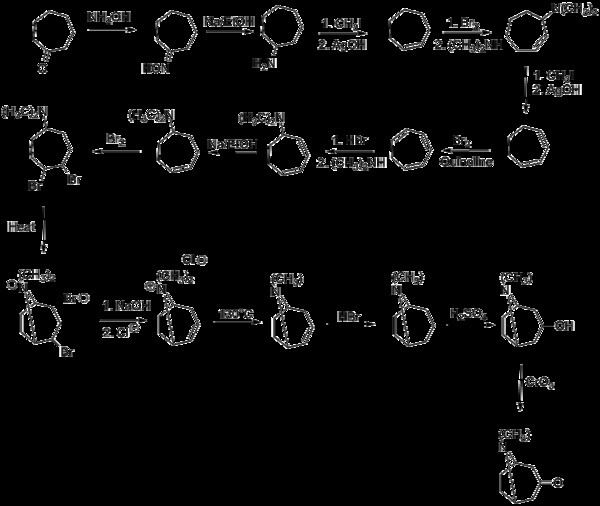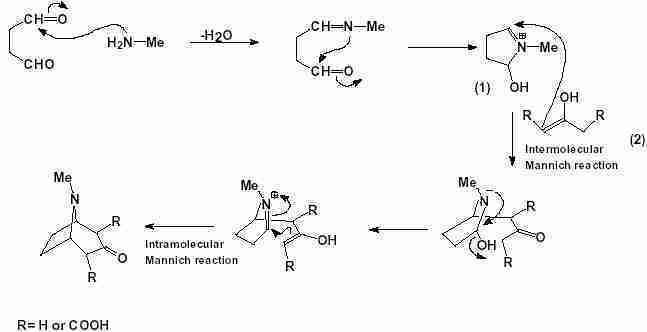Formula C8H13NO Appearance Brown solid | Molar mass 139.195 g/mol | |
 | ||
How to say tropinone high quality voices
Tropinone is an alkaloid, famously synthesised in 1917 by Robert Robinson as a synthetic precursor to atropine, a scarce commodity during World War I. Tropinone and the alkaloids cocaine and atropine all share the same tropane core structure.
Contents
- How to say tropinone high quality voices
- How to pronounce tropinone
- Synthesis
- Robinsons double Mannich reaction
- Reaction mechanism
- References

How to pronounce tropinone
Synthesis

The first synthesis of tropinone was by Richard Willstätter in 1901. It started from the seemingly related cycloheptanone, but required many steps to introduce the nitrogen bridge; the overall yield for the synthesis path is only 0.75%. Willstätter had previously synthesized cocaine from tropinone, in what was the first synthesis and elucidation of the structure of cocaine.
Robinson's "double Mannich" reaction

The 1917 synthesis by Robinson is considered a classic in total synthesis due to its simplicity and biomimetic approach. Tropinone is a bicyclic molecule, but the reactants used in its preparation are fairly simple: succinaldehyde, methylamine and acetonedicarboxylic acid (or even acetone). The synthesis is a good example of a biomimetic reaction or biogenetic-type synthesis because biosynthesis makes use of the same building blocks. It also demonstrates a tandem reaction in a one-pot synthesis. Furthermore, the yield of the synthesis was 17% and with subsequent improvements exceeded 90%.

This reaction is described as an Intramolecular "double Mannich reaction" for obvious reasons. It is not unique in this regard, as others have also attempted it in piperidine synthesis.

In place of acetone, acetonedicarboxylic acid is known as the "synthetic equivalent" the 1,3-dicarboxylic acid groups are so-called "activating groups" to facilitate the ring forming reactions. The calcium salt is there as a "buffer" as it is claimed that higher yields are possible if the reaction is conducted at "physiological pH".
Reaction mechanism
The main features apparent from the reaction sequence below are:

- Nucleophilic addition of methylamine to succinaldehyde, followed by loss of water to create an imine
- Intramolecular addition of the imine to the second aldehyde unit and first ring closure
- Intermolecular Mannich reaction of the enolate of acetone dicarboxylate
- New enolate formation and new imine formation with loss of water for
- Second intramolecular mannich reaction and second ring closure
- Loss of 2 carboxylic groups to tropinone
Some authors have actually tried to retain one of the CO2H groups.
CO2R-tropinone has 4 stereoisomers, although the corresponding ecgonidine alkyl ester has only a pair of enantiomers.
